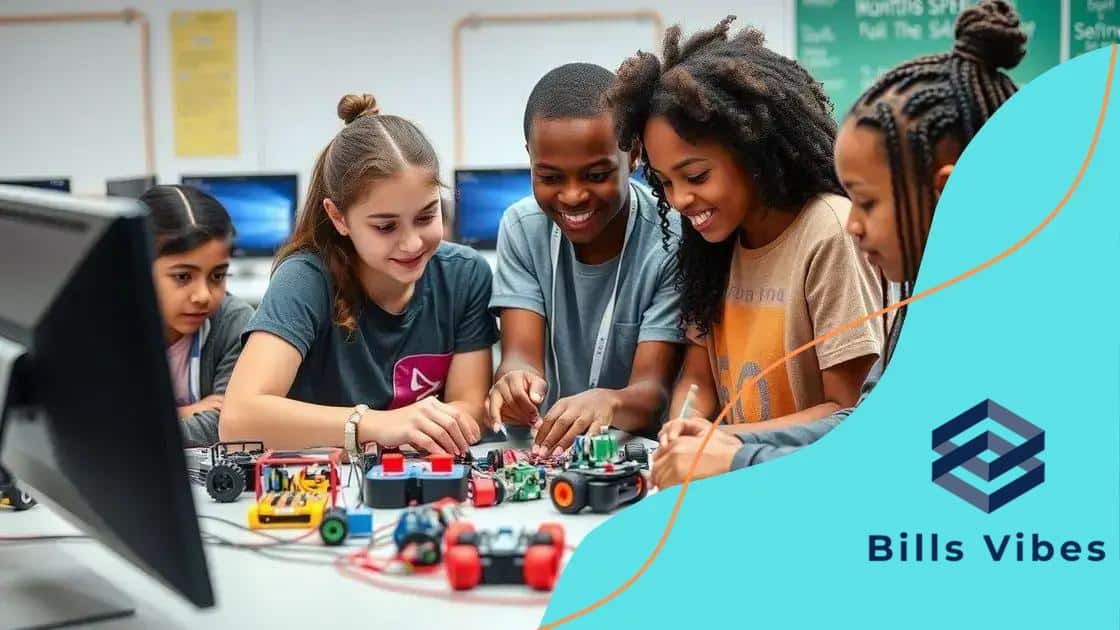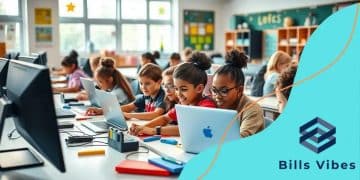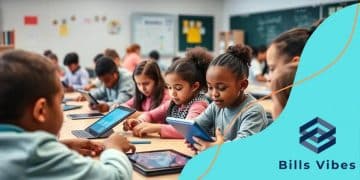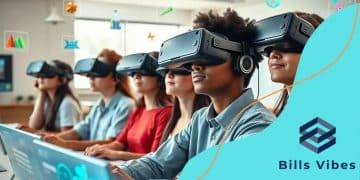Future of STEM programs: transforming education today

The future of STEM programs focuses on innovative teaching methods, technology integration, and real-world applications to engage students and prepare them for successful careers in science, technology, engineering, and mathematics.
Future of STEM programs is an exciting topic that sparks curiosity. With rapidly evolving technologies, students today have unique opportunities to engage in science, technology, engineering, and mathematics. But, how are these programs paving the way for the next generation?
The importance of STEM education in the 21st century
In today’s fast-paced world, the importance of STEM education cannot be overstated. As technology becomes more integrated into our daily lives, understanding the principles of science, technology, engineering, and mathematics is essential for students.
STEM education provides students with critical thinking skills, problem-solving abilities, and innovative mindsets. These skills are crucial for careers that are continuously evolving.
Why STEM Matters
STEM programs help to prepare students for a variety of fields. Graduates with strong skills in these areas often find themselves in high demand. Employers value the analytical and technical proficiency that comes with a solid understanding of STEM.
Benefits of STEM Learning
- Encourages creativity and innovation
- Develops teamwork and collaboration
- Fosters adaptability to new technologies
- Prepares students for future job markets
Moreover, STEM education fosters a spirit of curiosity and exploration. Students are encouraged to ask questions and seek answers, which leads to deeper understanding and retention of knowledge. This sense of inquiry is vital in a world that is rapidly changing.
As we look ahead, the need for skilled workers in STEM fields will only grow. Preparing our youth through comprehensive STEM programs ensures they are ready for both current and future challenges.
Innovative teaching methods in STEM programs
When we discuss innovative teaching methods in STEM programs, we explore fresh approaches that engage students and make learning more effective. Teachers are developing unique strategies to capture students’ interest and promote active learning.
One popular approach is project-based learning. In this method, students work on real-world projects that require them to apply scientific principles and mathematical knowledge. This hands-on learning helps students see the relevance of what they are studying in their everyday lives.
Interactive Learning Environments
Another innovative method is the use of technology to create interactive learning environments. By using tools like virtual reality (VR) and augmented reality (AR), educators can immerse students in complex concepts. For example, VR can allow students to explore the human anatomy or simulate a physics experiment without leaving the classroom.
Collaborative Learning
- Encourages teamwork among students
- Fosters communication skills
- Promotes peer learning
- Builds problem-solving abilities
Collaboration is also key in modern STEM education. Teachers often encourage group work, where students tackle challenges together. This not only enhances their understanding of the subject matter but also helps them develop important skills for the workforce.
In addition, flipped classrooms are gaining traction. In this model, students study instructional content at home, usually through video lectures, and engage in hands-on activities during class time. This method maximizes classroom interaction and allows teachers to provide more personalized support to each student.
How to engage students in STEM fields

Engaging students in STEM fields is essential for their academic success and future careers. To achieve this, teachers can implement creative strategies that make learning enjoyable and relevant. One way to engage students is by connecting classroom topics to real-world applications.
For instance, when teaching physics, a teacher might incorporate real-life examples such as vehicles or sports to demonstrate complex concepts. This approach helps students see the relevance of what they are learning and sparks their interest.
Interactive Learning Techniques
Interactive learning techniques also play a crucial role in engaging students. By incorporating activities like experiments, simulations, and group projects, educators can create a dynamic classroom environment. These techniques encourage students to take part actively, making learning more memorable.
Utilizing Technology
- Incorporate educational apps and games
- Use online resources for collaborative projects
- Integrate coding and robotics into lessons
- Facilitate virtual field trips through technology
Moreover, utilizing technology in the classroom can further enhance student engagement. Technology provides students with various tools to explore and express their ideas. When students use educational software or coding platforms, they find learning not only accessible but also fun.
Another effective method is to introduce mentorship opportunities. Connecting students with professionals in STEM careers can ignite their passion and provide insight into possible futures. Mentors can share their experiences and guide students in exploring different paths within STEM fields.
The role of technology in enhancing STEM curricula
The integration of technology plays a vital role in enhancing STEM curricula. By utilizing various technological tools, educators can create more engaging and effective learning environments. Technology allows for personalized learning experiences where students can work at their own pace and explore subjects that interest them.
One prominent aspect is the use of simulation software. This software enables students to visualize complex concepts such as chemical reactions or engineering principles. By simulating real-world scenarios, students better grasp challenging ideas and see the practical applications of what they learn.
Digital Resources for Learning
Furthermore, digital resources like online courses and interactive tutorials allow students to access a wealth of information beyond traditional textbooks. These resources keep students engaged and motivated, as they can learn through various formats, including videos, quizzes, and interactive exercises.
Collaboration through Technology
- Encourages teamwork and communication
- Facilitates project-based learning
- Enhances research capabilities
- Connects students with experts and mentors
Moreover, technology fosters collaboration among students. Tools like shared digital workspaces and communication platforms enable students to work together on projects, regardless of their location. This collaboration not only enhances learning but also builds essential skills for the workforce.
Teacher training is also crucial. Educators need to stay updated with the latest technological advancements to effectively incorporate them into the classroom. By embracing technology, teachers can inspire students to develop a passion for STEM subjects and equip them with the skills they need for future success.
Future trends in STEM education
As we look ahead, future trends in STEM education are evolving rapidly. These trends focus on making learning more engaging and relevant for students. One significant trend is the increased integration of artificial intelligence in classrooms. AI tools can personalize learning experiences, adapting to each student’s unique needs.
Another important aspect is the emphasis on interdisciplinary approaches. Educators are combining subjects like science, technology, engineering, and math with the arts, creating STEAM programs. This integration encourages creativity and critical thinking, allowing students to see the connections between different fields.
Project-Based Learning
Project-based learning is gaining popularity as it encourages students to work on real-world problems. By tackling relevant issues, students apply their knowledge in meaningful ways. Learning through projects helps foster teamwork and communication skills, which are essential in any career.
Remote and Hybrid Learning
- Flexibility in learning environments
- Access to diverse resources and experts
- Increased use of online platforms
- Development of self-directed learning skills
The rise of remote and hybrid learning models offers more flexibility for students. This approach allows learners to access materials and collaborate with peers from anywhere. As education becomes more digital, students will need to develop skills for self-directed learning, preparing them for future challenges.
Furthermore, a focus on coding and computational thinking is becoming essential in STEM education. Many schools are incorporating coding workshops and classes into their curricula, enabling students to develop technical skills that will be in high demand in the job market. Engaging students in coding from an early age builds their confidence and creativity.
FAQ – Frequently Asked Questions about the Future of STEM Education
What are the key benefits of STEM education?
STEM education encourages critical thinking, problem-solving skills, and creativity, preparing students for various career opportunities.
How does technology enhance STEM learning?
Technology provides interactive tools and resources, making learning more engaging and allowing personalized educational experiences.
What role does project-based learning play in STEM education?
Project-based learning helps students apply their knowledge to real-world problems, fostering teamwork and practical skills.
Why is coding important for students?
Coding skills are essential in today’s job market, encouraging students to think logically and develop solutions to complex problems.






